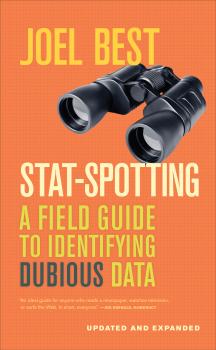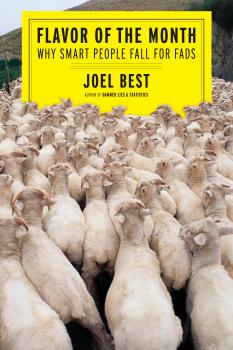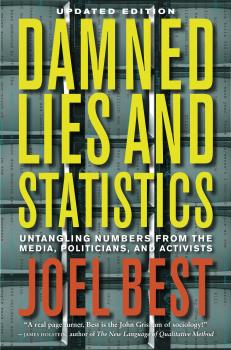ТОП просматриваемых книг сайта:
Joel Best
Список книг автора Joel BestАннотация
The myths and truths of teen's sexual behavior. Winner of the 2015 Brian McConnell Book Award presented by the International Society for Contemporary Legend Research To hear mainstream media sources tell it, the sexlives of modern teenagers outpace even the smuttiest of cable television shows.Teen girls “sext” explicit photos to boys they like; they wear “sex bracelets”that signify what sexual activities they have done, or will do; they team upwith other girls at “rainbow parties” to perform sex acts on groups of willingteen boys; they form “pregnancy pacts” with their best girlfriends to allbecome teen mothers at the same time. From The Today Show, to CNN, to the New York Times, stories of these eventshave been featured widely in the media. But are most teenage—oryounger—children really going to sex parties and having multiple sexualencounters in an orgy-like fashion? Researcherssay no—teen sex is actually not rampant and teen pregnancy is at low levels.But why do stories like these find such media traffic, exploiting parents’worst fears? How do these rumors get started, and how do they travel around thecountry and even across the globe? In Kids Gone Wild,best-selling authors Joel Best and Kathleen A. Bogle use these stories aboutthe fears of the growing sexualization of childhood to explore what we knowabout contemporary legends and how both traditional media and the internet perpetuatethese rumors while, at times, debating their authenticity. Best and Bogledescribe the process by which such stories spread, trace how and to where they have moved, and track howthey can morph as they travel from one medium to another. Ultimately, they findthat our society’s view of kids raging out of control has drastic andunforeseen consequences, fueling the debate on sex education and affecting policydecisions on everything from the availability of the morning after pill to whois included on sex offender registries. Asurprising look at the truth behind the sensationalism in our culture, Kids Gone Wild is a much-needed wake-upcall for a society determined to believe the worst about its young people.
Аннотация
In an accessible and droll style, well-known sociologist Joel Best shines a light on how we navigate these anxious, insecure social times. While most of us still strive for the American Dream—to graduate from college, own a home, work toward early retirement—recent generations have been told that the next generation will not be able to achieve these goals, that things are getting—or are on the verge of getting—worse. In <I>American Nightmares</I><I>,</I> Best addresses the apprehension that we face every day as we are bombarded with threats that the social institutions we count on are imperiled. Our schools are failing to teach our kids. Healthcare may soon be harder to obtain. We can’t bank on our retirement plans. And our homes—still the largest chunk of most people’s net worth—may lose much of their value. Our very way of life is being threatened! Or is it? With a steady voice and keen focus, Best examines how a culture develops fears and fantasies and how these visions are created and recreated in every generation. By dismantling current ideas about the future, collective memory, and sociology’s marginalization in the public square, Best sheds light on how social problems—and our anxiety about them—are socially constructed.<BR /><BR />  
Аннотация
This illuminating investigation uncovers the full dimensions of the student loan disaster. A father and son team—one a best-selling sociologist, the other a former banker and current quantitative researcher—probes how we’ve reached the point at which student loan debt—now exceeding $1 trillion and predicted to reach $2 trillion by 2020—threatens to become the sequel to the mortgage meltdown. In spite of their good intentions, Americans have allowed concerns about deadbeat students, crushing debt, exploitative for-profit colleges, and changing attitudes about the purpose of college education to blind them to a growing crisis.<br> <br> With college costs climbing faster than the cost of living, how can access to higher education remain a central part of the American dream? With more than half of college students carrying an average debt of $27,000 at graduation, what are the prospects for young adults in the current economy? Examining how we’ve arrived at and how we might extricate ourselves from this grave social problem, <i>The Student Loan Mess</i> is a must-read for everyone concerned about the future of American education.<br> <br> Hard facts about the student loan crisis:<br> <br> • Student loan debt is rising by more than $100 billion every year.<br> • Among recent college students who are supposed to be repaying their loans, more than a third are delinquent.<br> • Because student loans cannot be discharged through bankruptcy, the federal government misleadingly treats student loan debt as a government asset.<br> • Higher default rates, spiraling college costs, and proposals for more generous terms for student borrowers make it increasingly likely that student loan policies will eventually cost taxpayers hundreds of billions of dollars.
Аннотация
Every kindergarten soccer player gets a trophy. Many high schools name dozens of seniors as valedictorians—of the same class. Cars sport bumper stickers that read «USA—Number 1.» Prizes proliferate in every corner of American society, and excellence is trumpeted with ratings that range from «Academy Award winner!» to «Best Neighborhood Pizza!» In <i>Everyone’s a Winner</i>, Joel Best— acclaimed author of <i>Damned Lies and Statistics</i> and many other books—shines a bright light on the increasing abundance of status in our society and considers what it all means. With humor and insight, Best argues that status affluence fosters social worlds and, in the process, helps give meaning to life in a large society.
Аннотация
Does a young person commit suicide every thirteen minutes in the United States? Are four million women really battered to death by their husbands or boyfriends each year? Is methamphetamine our number one drug problem today? Alarming statistics bombard our daily lives, appearing in the news, on the Web, seemingly everywhere. But all too often, even the most respected publications present numbers that are miscalculated, misinterpreted, hyped, or simply misleading.<br> <br> This new edition contains revised benchmark statistics, updated resources, and a new section on the rhetorical uses of statistics, complete with new problems to be spotted and new examples illustrating those problems. Joel Best’s best seller exposes questionable uses of statistics and guides the reader toward becoming a more critical, savvy consumer of news, information, and data.<br> <br> Entertaining, informative, and concise, <i>Stat-Spotting</i> takes a commonsense approach to understanding data and doesn't require advanced math or statistics.
Аннотация
Here, by popular demand, is the updated edition to Joel Best's classic guide to understanding how numbers can confuse us. In his new afterword, Best uses examples from recent policy debates to reflect on the challenges to improving statistical literacy. Since its publication ten years ago, <i>Damned Lies and Statistics</i> has emerged as the go-to handbook for spotting bad statistics and learning to think critically about these influential numbers.








